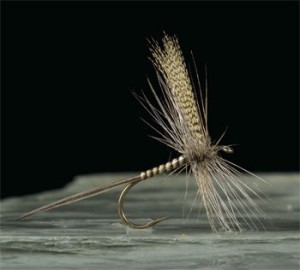by Levi Opsatnic
The Quill Gordon can be viewed as one of the mayflies that begin the dry fly season. With its dark green and pale yellow body, this insect almost looks as if it is representing the change in nature: from the dominant Evergreen trees of the winter to the lush yellow color that encompasses most fresh spring or summer foliage.
The Quill Gordon is a mayfly that prefers to live in fast and clean water and has a fairly unordinary method of hatching. This mayfly emerges from their nymphal shucks below the water’s surface while still attached to the stream bed. This odd behavior is common to few species of mayflies and is something that lends itself more to fishing a winged wet fly pattern than other species of mayflies.
The nymph of this insect is also something that possesses some strange qualities and should be reflected in the patterns created to imitate this insect. The Quill Gordon nymph is fairly flat in appearance, with wide gills along both sides of its body, and only two tails. As a result of this, the nymphal representations should possess all three of those qualities in order to be most effective. The hatching of these nymphs usually takes place in the middle of the day once the sun moves to about the middle of the sky enough to hit the water.
The dun form of the Quill Gordon, much like its other stages of life, has one odd quality: once these mayflies begin to hatch on any area of water, they generally continue to emerge each day regardless of the weather. This means two things to the angler: regular fishing to this hatch can be had once an area that holds the Quill Gordon is found; and this hatch will be short lived since the nymphs hatch with such furiousness once they begin.
Another important aspect of the Quill Gordon dun is that as a result of its manner of hatching, the adults will usually need to ride the surface for a longer amount of time than other mayflies in order to properly dry their wings. To the trout and angler, this means that the adults will usually stay on the surface long enough to fall prey to a hungry trout.
The spinner form of the Quill Gordon displays behavior that is similar to most other spinners, flying over the water and occasionally dancing to the surface to deposit some eggs. Like most spinners, this occurs until the males and females are tired from all of the mating and fall “spent” on the surface where they will most likely become a meal to a fish.
What does all of this information about the life of a Quill Gordon mean to the fly fisher and the fly box? One should adapt their flies to properly represent the strange forms of life that a Quill Gordon mayfly has.
When it comes to fishing the Quill Gordon nymph form, an effective pattern could be a modified Hare’s Ear nymph that has a flattened appearance, abdomen with dark qualities on top, and dubbing picked out heavily on either sides of the abdomen to represent the large gills that are found on these mayflies.
Now, one of the most integral stages of this mayfly’s life is its departure from its nymphal case through the surface film to its beginning as an adult. Since this mayfly must frantically elevate through the water columns as an adult, it can be a very easy meal to a trout. That said, a winged wet fly pattern is extremely effective in the beginning of this hatch. A prime pattern that will undoubtedly catch fish is the Quill Gordon wet fly; however, mostly any wet fly with a dun to olive body and mottled wings will prove effective.
The next important step to this fly’s life cycle is its adult dun stage. This is the portion of this mayfly’s life when it provides the most excitement to the angler as a result of it being matched very well with a high floating dry fly. Although this pattern is more than fruitful, I actually have a partiality to tying my adult imitations as a parachute style dry with a tail of medium dun microfibbets (tied split as to recreate the two tails that this adult has); a body of olive hares mask blended with some muskrat, ribbed with a pale yellow embroidery floss; a parachute post wing of mallard flank; and a dark dun hackle to finish it off. I feel that this pattern does a fine job at imitating the olive tones that I have found to be so prevalent on the wild Pennsylvanian trout waters that I regularly fish. As far as the spinner goes, I usually just stick with a slimmer version of my parachute dun.
The Quill Gordon is a mayfly that presents a solid an opportunity to landing a trout as any. Due to the peculiar nature of this insect’s hatching behavior, it presents the angler with versatility effectively fishing as a nymph, wet fly, dry fly, and spinner all in the course of one day. And as the angler, if a stream holds a good population of these insects, then it would be beneficial to pay particular attention to that stream and ensure that you are doing everything in your power to keep it as healthy as possible.
For more information, check out “The Dry Fly and The Top Water Game” DVD by Joe Humphreys.

